![]()
![]()
![]()
Use LEFT and RIGHT arrow keys to navigate between flashcards;
Use UP and DOWN arrow keys to flip the card;
H to show hint;
A reads text to speech;
59 Cards in this Set
- Front
- Back
|
What are enzymes?
|
Large proteins that are biologic catalysts and increase the rate of a chemical reaction without themselves becoming part of the product.
|
|
|
What are all digestive enzymes classified as?
|
Hydrolases
Break down organic food molecules by adding water to the molecular bonds, thus cleaving the bonds between the subunits or monomers |
|
|
Why can digestive enzymes be studied in a test tube?
|
They function outside the body cells in the digestive tract, so their hydrolytic activity can be studied in vitro
|
|
|
Where is salivary amylase made and secreted?
|
Made in parotid salivary glands, sublingual salivary glands and submandibular salivary glands
Secreted into the mouth |
|
|
What does salivary amylase do?
|
Hydrolyzes starch to maltose
|
|
|
Why must controls be prepared?
|
We need to identify the presence of starch, water and amylase at the beginning to determine to what extent the activity has occured; must provide a known standard against which comparisons can be made
|
|
|
What is the equation of starch to maltose?
|
Starch + water + amylase --> maltose (units) + amylase
As starch decreases, sugar increases as digestion occurs |
|
|
What does the IKI test determine?
|
Whether starch is present in your final solution or not (don't want any present, want it all converted to maltose)
Blue/black color=starch present=positive starch test Otherwise negative starch test, starch not present |
|
|
What does Benedict's solution test?
|
Whether maltose is present or not
Put drops in mixture and boil --green/orange precipitate forms, maltose present, positive sugar test --otherwise negative sugar test, no color change |
|
|
What were the ideal conditions for the amylase digestion of starch to take place?
|
Incubated at 37 degrees; would get negative IKI test and positive benedict's test (no starch present, maltose present)
When incubated at 0 degrees, get some sugar but not a whole lot, still have starch When boil amylase, get starch but no sugar---denatured enzyme |
|
|
Where are monosaccharides absorbed once broken down?
|
Into intestinal villi; transported via hepatic portal vein to the liver
|
|

Label this chart:
|
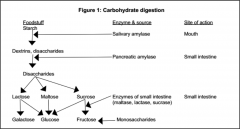
|
|
|
How exactly does Bennedict's test work? (determines if sugar is present)
|

It searches for the presence of "reducing sugars", or sugars with aldehydes. i.e. if a sugar has been broken up, it will probably have aldehydes on its end
Cu +2 is reduced to Cu +1 by reducing sugar which precipitates as a red copper oxide |
|
|
How do amino acids get absorbed?
|
Absorbed into the intestinal villi and transported via the hepatic portal vein to the liver
|
|
|
How does the IKI test work?
|
Iodine ions in potassium iodide solution react with starch to change color of the solution
|
|
|
What is trypsin and what does it do?
|
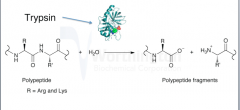
An enzyme produced by the pancreas
Hydrolyzes proteins to small fragments (proteoses, peptones and peptides) |
|
|
What is BAPNA?
|
A synthetic protein substrate consisting of a dye covalently bound to an amino acid
|
|
|
What happens in trypsin hydrolysis of BAPNA?
|
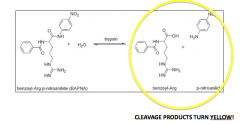
Cleaves the dye molecule from the amino acid, causing the solution to change from colorless to yellow
|
|
|
Why are additional tests not needed in Activity B, with Trypsin and BAPNA?
|
The covalent bond between the dye molecule and amino acid is the same as the peptide bonds that link amino acids together, so the appearance of yellow indicates the presence and activity of an enzyme capable of peptide bond hydrolysis.
Basically: The color change is direct evidence of hydrolysis. If the mixture remains clear, no detectable hydrolysis has happened. |
|
|
Draw the flowchart for protein digestion.
|
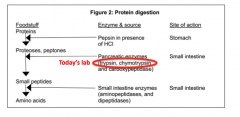
|
|
|
What were the best conditions for the hydrolysis of protein with trypsin and BAPNA?
|
Occurred at both 37 degrees C and 0 degrees C; when we boiled the trypsin first it didn't work because our enzyme ended up becoming denatured
|
|
|
How are lipids absorbed in the body?
|
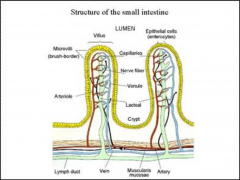
By lacteals in the villi and into the lymphatic vessels and eventually into the blood circulation.
|
|
|
How are fats and oils digested and how is this different than proteins and carbs?
|
Must go through more complicated treatment...two steps:
1. Fats/oils are EMULSIFIED in the presence of bile salts to make droplets 2. The droplets are digested by lipase to free fatty acids and glycerides |
|
|
What does pancreatin mean?
|
The enzymatic product of the pancreas, which includes protein, carbohydrate, nucleic acid and fat-digesting enzymes.
|
|
|
What is pancreatic lipase?
|
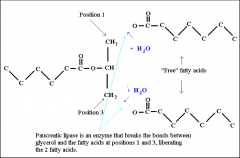
Hydrolyzes fats and oils to monoglycerides and two fatty acids (and occasionally to glycerol and three fatty acids)
|
|
|
What is an easy way to determine if fat digestion has taken place?
|
Test pH using litmus blue, which changes from blue to pink as contents become acid.
Some of the end products of fat digestion are organic acids that decrease the pH, so we use pH to recognize the step of digestion of fats we are in. |
|
|
What is bile?
|
Not an enzyme but a secretary product of the liver that is still important
Important to fat digestion because of its emulsifying action--the physical breakdown of larger particles into smaller ones, which provide a larger surface area. |
|
|
How did we demonstrate emusification of lipids?
|
Added water, vegetable oil and a pinch of bile salts to test tubes, shook and let stand at room temperature
If emulsification did not occur: oil floats on surface of water If it did occur: fat droplets will be suspended throughout water, forming an emulsion (7L) |
|
|
How did we test to see if lipid hydrolysis occurred?
|
Put litmus cream (cream providing fat substance with litmus powder) and lipase in tubes, incubated for certain amounts of time...color control (.1 N HCl) added to tubes 1L and 2L only
When tubes turned pink, it meant hydrolysis had occurred, no additional assay reagents necessary |
|
|
What were the most favorable conditions of lipid hydrolysis?
|
Incubated for 37 degrees C; that's where we got the color change
0 degrees too cold, boiled lipase denatured it |
|
|
What were the results of the lipid hydrolysis experiment with the control tubes, 1L and 2L?
|
Added .1 N HCl to both
In 1L, since no lipid present, still did not get color change In 2L, since lipid present but no lipase, wouldn't normally get color change but since we added the acid, we did |
|
|
What kinds of muscles are involved in movement of foods down digestive tract?
|
Smooth and skeletal
|
|
|
What is swallowing?
|
i.e. deglutition
Skeletal muscle activity 2 steps = buccal and pharyngeal-esophageal |
|
|
Describe the two phases of deglutition
|
Buccal: voluntary, controlled and initiated by the tongue
Pharyngeal-esophageal: involuntary, works through peristalsis, results in delivery of contents to stomach |
|
|
What two sounds can you hear in stomach when you take a swallow of water?
|
Gastroesophageal sphincter: water splashes against it
Second when peristalic wave of esophagus arrives at sphincter and it opens, allowing water to enter stomach |
|
|
What is a catalyst?
|
Increases the rate of a chemical reaction without becoming part of the product
|
|
|
What is a control?
|
Provides a standard of comparison for test results
|
|
|
What is an enzyme?
|
Biologic catalyst that is a protein in nature
|
|
|
What is a substrate?
|
Substance on which a catalyst works
|
|
|
List three characteristics of enzymes
|
1. Not used up in the reaction/does not change shape
2. Used to speed up a reaction 3. Will bind to a molecule if the enzyme-substrate complex can form (highly specific) |
|
|
The enzymes of the digestive system are classified as hydrolyses. What does this mean?
|
They catalyze digestive hydrolysis reactions
|
|
|
What produces salivary amylase, where is its site of action and what is the substrate?
|
Salivary glands
Mouth Starch |
|
|
What produces trypsin, what is the site of action and what is its substrate?
|
Pancreas (exocrine)
Small intestine Proteins |
|
|
What makes pancreatic lipase, where is its site of action and what is its substrate?
|
Pancreas (exocrine)
Small intestine Fats |
|
|
What is the end products of digestion for proteins?
|
Amino acids
|
|
|
What are the end products of digestion for carbohydrates?
|
Simple sugars (monosaccharides/disaccharides)
|
|
|
What are the end products of digestion for fats?
|
Fatty acids and glycerol
|
|
|
What conclusions can you draw when an experimental sample gives both a positive starch test and a positive maltose test after incubation?
|
Not all starch has been broken down and converted to maltose/amylase
|
|
|
Why was 37 degrees C the optimal incubation temperature?
|
Because the body's enzymes work at their optimum temperature
Also, enzymes encounter substrate molecules more slowly at lower temperature |
|
|
Why did very little, if any, starch digestion occur in test tube 6A? (incubation at 0 degrees C)
|
The temperature conditions were not ideal fo amylase to work
|
|
|
In the exercise concerning trypsin function, why was an enzyme assay like Benedict's or Lugol's IKI (which test for the presence of a reaction product) NOT necessary?
|
Because the color change from clear to yellow is direct evidence of hydrolysis--additional tests are not required
The other tests measure cleavage products, so are indirect |
|
|
Why did you do tube 1T? (no BAPNA)
|
It was a negative control. BAPNA causes a color change when trypsin hydrolysis occurs. Since we didn't add BAPNA in the tube, if we get a color change we know our experiment is invalid and contaminated
|
|
|
Why did you do tube 2T? (no trypsin)
|
BAPNA only causes a color change in trypsin. Again, this is a control tube--if BAPNA causes a color change without trypsin present, our experiment is invalid/contaminated.
|
|
|
Trypsin is a protease similiar to pepsin, the protein-digesting enzyme in the stomach. Would trypsin work well in the stomach?
|
No because the stomach is highly acidic while trypsin works well in the neutral/basic environment of the small intestines
It would denature in the stomach |
|
|
In the procedure concerning pancreatic lipase digestion of fats, why did the litmus indicator change from blue to pink during fat hydrolysis?
|
Because the change of blue to pink indicates the presence of acids as is the case when fats are broken down into glycerol and fatty acids
|
|
|
What was used to test for protein hydrolysis, which was indicated by a yellow color?
|
BAPNA
|
|
|
What was used to test for the presence of starch, indicated by a blue-black color?
|
IKI (Lugol's iodine)
|
|
|
What was used to test for the presence of fatty acids, which was evidenced by a color change from blue to pink
|
Litmus
|
|
|
What was used to test for the presence of reducing sugars as indicated by a colored precipitate?
|
Bennedict's solution
|

